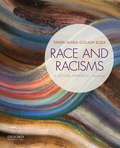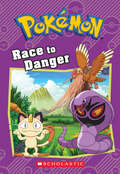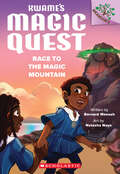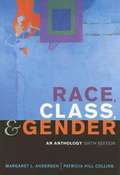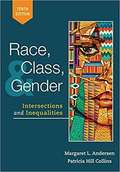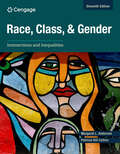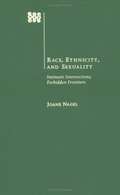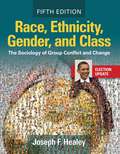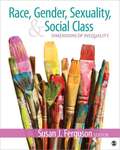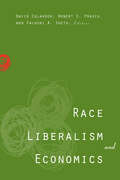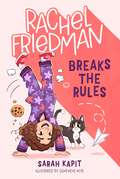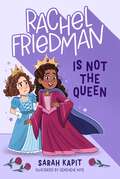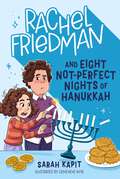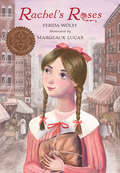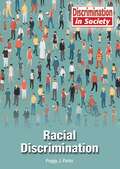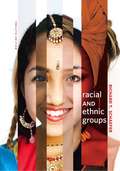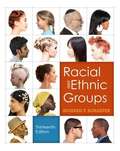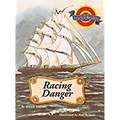- Table View
- List View
Race and Racisms: A Critical Approach
by Tanya Maria Golash-BozaRace and Racisms: A Critical Approach, Second Edition, engages students in significant--and timely--questions related to racial dynamics in the U.S. and around the world. Written in accessible, straightforward language, the book discusses and critically analyzes cutting-edge scholarship in the field.
Race to Danger (Pokémon Chapter Books)
by Tracey WestThis reissued illustrated chapter book is based on the classic characters found in Pokemon GO and the classic animated series on Netflix.The Pokémon hot air balloon race is on. And the prize is a rare Dratini. Windy could have won—but Team Rocket took the wind out of her sails! Can Ash and his Pokémon help Windy blow off the competition? Between hail storms, Beedrill swarms, Weezing's Smoke Screen and Arbok's balloon-tearing fangs, the odds are against them. It's going to take a lot to win this race—but Ash won't let Team Rocket burst anyone's bubble. This reissued illustrated chapter book is based on the classic characters found in Pokemon GO and the classic animated series on Netflix.
Race to the Magic Mountain: A Branches Book (Kwame's Magic Quest)
by Bernard MensahKwame must stop the green flame from destroying the world, in the second installment of this action-packed early chapter book series perfect for fans of Dragon Masters!Pick a book. Grow a Reader!This series is part of Scholastic's early chapter book line, Branches, aimed at newly independent readers. With easy-to-read text, high-interest content, fast-paced plots, and illustrations on every page, these books will boost reading confidence and stamina. Branches books help readers grow!An evil magic turned Kwame's friend Fifi into a green flame. It also stole the two most powerful calabashes, and now the world is falling apart! Kwame and his friends Esi and Papa-Kow must travel to the Magic Mountain, where the green flame is trying to combine the two calabashes to make one all-powerful calabash. Can they save Fifi and stop the green flame before it's too late?With engaging black-and-white artwork on every page, kids won't be able to put down this fully illustrated, magical, action-packed adventure!
Race, Class, and Gender: An Anthology (6th edition)
by Patricia Hill Collins Margaret L. AndersenThis anthology introduces students to how race, class, and gender shape the experiences of diverse groups in the U.S. Introductory essays for each of the four sections stress the interconnectedness of these various types of difference. Each section concludes with some suggestions for further reading. The sixth edition contains 19 new readings dealing with such issues as affirmative action, immigration, and military rank.
Race, Class, and Gender: Intersections and Inequalities
by Patricia Hill Collins Margaret L. AndersenTimely, relevant and extremely student-friendly, Andersen/Hill Collins' RACE, CLASS, AND GENDER: INTERSECTIONS AND INEQUALITIES, 10th edition, equips you with a multidimensional perspective on today's social issues. Written by two leading authorities in the field, this classic anthology uses a diverse collection of writings by a variety of scholars to demonstrate how the complex intersection of people's race, class, gender and sexuality shapes their experiences in U.S. society. Professors Andersen and Hill Collins begin each section with in-depth introductions to provide an analytical framework for understanding social inequality. Completely up-to-date, the readings cover current--and often controversial topics--including undocumented students, myths about immigrant crime, growing inequality, the role of social media in social movement mobilization, health care inequality and more.
Race, Class, and Gender: Intersections and Inequalities
by Patricia Hill Collins Margaret L. AndersenCo-edited by two leading authorities, Andersen/Hill Collins' RACE, CLASS, AND GENDER: INTERSECTIONS AND INEQUALITIES, 11th Edition, is a classic work that has defined the field of intersectionality studies. Updated to reflect the most current research and recent societal events, the readings in the 11th edition are especially timely, covering immigration and refugees, the Covid-19 pandemic, climate change, the rise of white nationalism, transgender identities, gun violence, precarious work, youth activism, the role of social media in social movement mobilization and more -- equipping readers with a multidimensional perspective on today's social issues. The 11th edition includes a new section on Analyzing Social Issues. Andersen and Hill Collins begin each section with in-depth introductions to provide an analytical framework for understanding social inequality.
Race, Ethnicity, And Sexuality: Intimate Intersections, Forbidden Frontiers
by Joane NagelWhat's sex got to do with race? With ethnicity? With nationalism? What do race, ethnicity, and nationalism have to do with sex? Race, Ethnicity, and Sexuality addresses these questions, exploring the intimate intersections and forbidden frontiers where ethnicity and sexuality meet face-to-face. Through numerous examples from the U. S. and beyond-and from the past and the present-the book illustrates the power of sex to shape ideas and feelings about race, ethnicity, and the nation. It shows how sexual images, fears, and desires help form racial, ethnic, and national stereotypes, differences, and conflicts. <p><p> In this unique work, Joane Nagel demonstrates how ethnicity and sexuality join hands to fashion new, hybrid identities, communities, and cultures; how the volatile mixture of race and sex can spark ethnic violence; and how ethnosexual encounters can simultaneously resist and reinforce racial,ethnic, and national boundaries. She skillfully blends styles of inquiry and interpretation from the social sciences and the humanities to craft a convincing and illuminating account using images, poetry, fieldwork, Internet postings, interviews, literature, ethnographies, historical texts, archival documents, biographies, census data, journals, and personal accounts. Race, Ethnicity, and Sexuality is an ideal text for undergraduate courses in race and ethnicity; sexuality; race/gender/class; gender studies; ethnic studies; multicultural and diversity studies; or globalization studies.
Race, Ethnicity, Gender, and Class: The Sociology of Group Conflict and Change (5th edition, Election Update)
by Joseph F. HealeyHealey (sociology, Christopher Newport U., Virginia) updates his textbook for undergraduate students, primarily but not exclusively those majoring in his discipline. He makes few assumptions about knowledge of history or sociological concepts. A unified set of themes and concepts links the multiple perspectives and on issues relating to minority groups in the US. This edition updates statistics, rearranges some of the text, adds and changes some visual elements, and provides a special report on the 2008 election. Chapters include debate questions, print and Web resources, questions for review and study, and an Internet research project. Annotation ©2009 Book News, Inc., Portland, OR (booknews.com)
Race, Gender, Sexuality, and Social Class: Dimensions of Inequality
by Susan J. FergusonRace, Gender, Sexuality, and Social Class: Dimensions of Inequality, edited by renowned researcher and scholar Susan Ferguson, presents a contemporary and compelling overview of race, ethnicity, gender, and social class issues in the United States today. Taking an intersectional approach, the book is organized topically, rather than focusing on specific race/ethnic subgroups. The content is framed around the themes of identity, experiences of race, class, gender or sexuality, difference, inequality, and social change or personal empowerment, with historical context threaded throughout to deepen the reader's understanding. With engaging readings and cutting-edge scholarship the collection is not only refreshingly contemporary but also relevant to students’ lives.
Race, Liberalism, and Economics
by Robert E. Prasch Falguni A. Sheth David C. ColanderNoneconomists often think that economists' approach to race is almost exclusively one of laissez-faire. Racism, Liberalism, and Economics argues that economists' ideas are more complicated. The book considers economists' support of markets in relation to the challenge of race and race relations and argues that their support of laissez-faire has traditionally been based upon a broader philosophical foundation of liberalism and history: what markets have and have not achieved in the past, and how that past relates to the future. The book discusses the concepts of liberalism and racism, the history and use of these terms, and how that history relates to policy issues. It argues that liberalism is consistent with a wide variety of policies and that the broader philosophical issues are central in choosing policies. The contributors show how the evolution of racist ideas has been a subtle process that is woven into larger movements in the development of scientific thought; economic thinking is embedded in a larger social milieu. Previous discussions of policies toward race have been constrained by that social milieu, and, since World War II, have largely focused on ending legislated and state-sanctioned discrimination. In the past decade, the broader policy debate has moved on to questions about the existence and relative importance of intangible sources of inequality, including market structure, information asymmetries, cumulative processes, and cultural and/or social capital. This book is a product of, and a contribution to, this modern discussion. It is uniquely transdisciplinary, with contributions by and discussions among economists, philosophers, anthropologists, and literature scholars. The volume first examines the early history of work on race by economists and social scientists more generally. It continues by surveying American economists on race and featuring contributions that embody more modern approaches to race within economics. Finally it explores several important policy issues that follow from the discussion. ". . . adds new insights that contribute significantly to the debate on racial economic inequality in the U. S. The differing opinions of the contributors provide the broad perspective needed to examine this extremely complex issue. " --James Peoples, University of Wisconsin-Milwaukee "There is an immense economic literature on racial discrimination, employing a variety of models and decomposition methods. This volume makes a unique contribution by focusing on the philosophical assumptions at the root of this analysis and by presenting many sides of the very vigorous debate surrounding these controversial issues. " --Thomas Maloney, University of Utah "By focusing upon the progress of analytical technique, historians of economic thought have grossly neglected the symbiotic relation of economics to public policy and ideology. This collection of essays offers a most welcome breach of disciplinary apartheid. Seizing upon recent research in the almost forgotten writings about race of Classical economists and their contemporaries, it relates nineteenth-century ideas to current debates about economic discrimination and other manifestations of racism. As the writing is both learned and lively, the book should appeal both to the generally educated reader and to teachers of courses in multiculturalism. " --Melvin Reder, Isidore Brown and Gladys J. Brown Professor Emeritus of Urban and Labor Economics, University of Chicago
Rachel Carson: A Voice for Nature (Fountas & Pinnell Classroom, Guided Reading)
by Claire GoldingNIMAC-sourced textbook
Rachel Carson: Caring for the Earth [Approaching Level, Grade 2]
by Kristi GramsNIMAC-sourced textbook
Rachel Friedman Breaks the Rules (Rachel Friedman #1)
by Sarah KapitIntroducing a charming chapter book series starring Rachel Friedman, a sweet and silly Jewish girl renowned for her peanut butter challah baking skills and larger-than-life personality!Rachel loves being Jewish, but she hates following the rules at synagogue—and everywhere else. To encourage her to see the value of rules, Rachel and her father strike a deal: If Rachel can stick to the rules for one whole week, she can go to a meet and greet for her favorite gymnast!But when Rachel finds herself in a tricky situation that forces her to choose between following the rules or doing what she believes is right, she learns that some rules are worth breaking. And yet, when the consequences of her rule breaking spin out of control, she learns that some rules are still worth following.Sarah Kapit creates a refreshing chapter book heroine in Rachel Friedman, featuring her identity, ADHD, and personality with care. The book also features Genevieve Kote's adorable illustrations throughout.
Rachel Friedman Is Not the Queen (Rachel Friedman)
by Sarah KapitIn this heartwarming chapter book, Rachel celebrates Purim—and learns the joy of sharing the stage.Rachel is so excited about Purim, and she's especially excited to star in her Hebrew school's Purim spiel! She'll get to dress up like a queen and put on a play in front of everyone.But when her teacher announces the cast, Rachel doesn't get the leading role of Queen Esther—her best friend Maya does! Rachel has to learn how to step aside and let someone else be the star of the show in this laugh-out-loud story about friendship.
Rachel Friedman and Eight Not-Perfect Nights of Hanukkah (Rachel Friedman #2)
by Sarah KapitJoin our hilarious Jewish heroine as she embarks on a quest to reignite her family's Hanukkah spirit in the second book of this chapter book series.Rachel is determined to make this the happiest Hanukkah ever. She's carefully planned eight awesome activities for eight perfect nights. But her brother Aaron insists on being a Hanukkah humbug, and his attitude threatens to ruin the holiday. When Aaron’s grumpiness leads to a big accident, Rachel has to figure out how to save her family’s Hanukkah from disaster. Rachel has plenty of determination, creativity, and holiday spirit—will it be enough to restore the joy of Hanukkah?
Rachel's Roses
by Ferida WolffRachel Berger needs twenty-five cents to make her dream come true. But for Rachel, twenty-five cents is a fortune--and she's running out of time.Third-grader Rachel Berger longs to be different. At the very least, she'd like to be set apart from her copycat little sister, Hannah. The second Rachel spots the glass rose buttons at Mr. Solomon's button shop, her heart stops. They'll be the perfect, unique touch on the skirt her mother is making her for Rosh Hashanah. There's just one problem: Rachel can't afford them. With her focus set on earning enough to buy them before the holiday, will Rachel lose sight of what's really important?Themes of sisterhood, sibling rivalry, and strong family values are organically woven in to this charmingly illustrated chapter book set on the Lower East Side of Manhattan in the early twentieth century.
Racial Discrimination (Discrimination in Society)
by Peggy J. ParksThe term "racial discrimination" refers to people being treated unequally and unfairly solely because of their race. Although it is a considered a problem throughout the United States, not everyone agrees about the seriousness of it. <p><p> Racial Discrimination examines what this discrimination entails, how it is manifested, how widespread it is, how it affects real people, and efforts to address this discrimination.
Racial and Ethnic Groups (12th edition)
by Richard T. SchaeferNew edition of a standard textbook for a course on race/ethnic relations.
Racial and Ethnic Groups (13th Edition)
by Richard T. SchaeferThe 13th edition of Schaefer's Racial and Ethnic Groups places current and ethnic relations in a socio-historical context to help readers understand the past and shape the future. This best-selling Race & Ethnic Relations text is grounded in a socio-historical perspective with engaging stories and first person accounts. Race and Ethnic Groups helps students understand the changing dynamics of the U. S. population by examining our history, exploring our current situation, and discussing concerns for the future. This text provides an accessible, comprehensive, and up-to-date introduction to the present issues that confront racial and ethnic groups in the U. S. and around the world. It incorporates the most current statistics and data in the marketplace including the most recent census.
Racing Against Hate: The Story of Marshall Taylor (Fountas & Pinnell Classroom, Guided Reading Grade 6)
by Michele Spirn Chuck PyleA World Champion Cyclist In the early 1900s, Marshall Taylor was an international cycling star. But as an African-American rider competing against white riders, Taylor also had to battle prejudice while he pedaled his way to victory. NIMAC-sourced textbook
Racing at the Dunes (Fountas & Pinnell Classroom, Guided Reading)
by Nancy Wallace Niklas AskerNIMAC-sourced textbook
